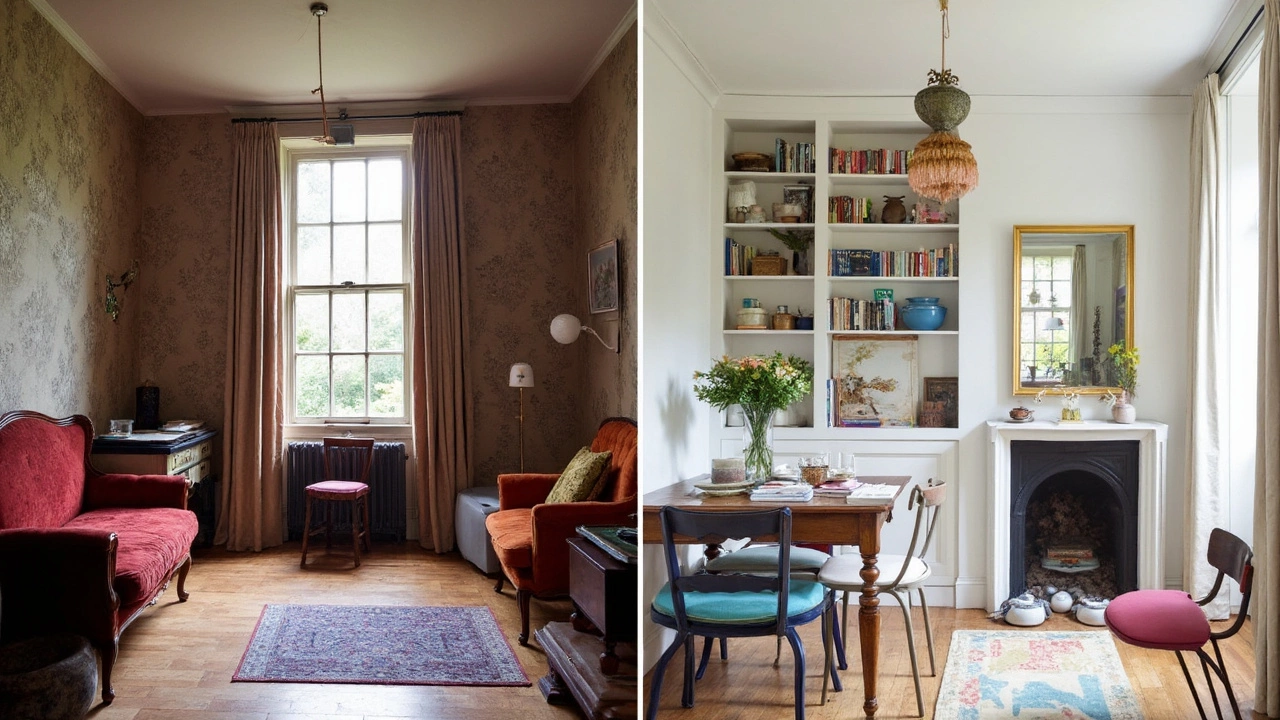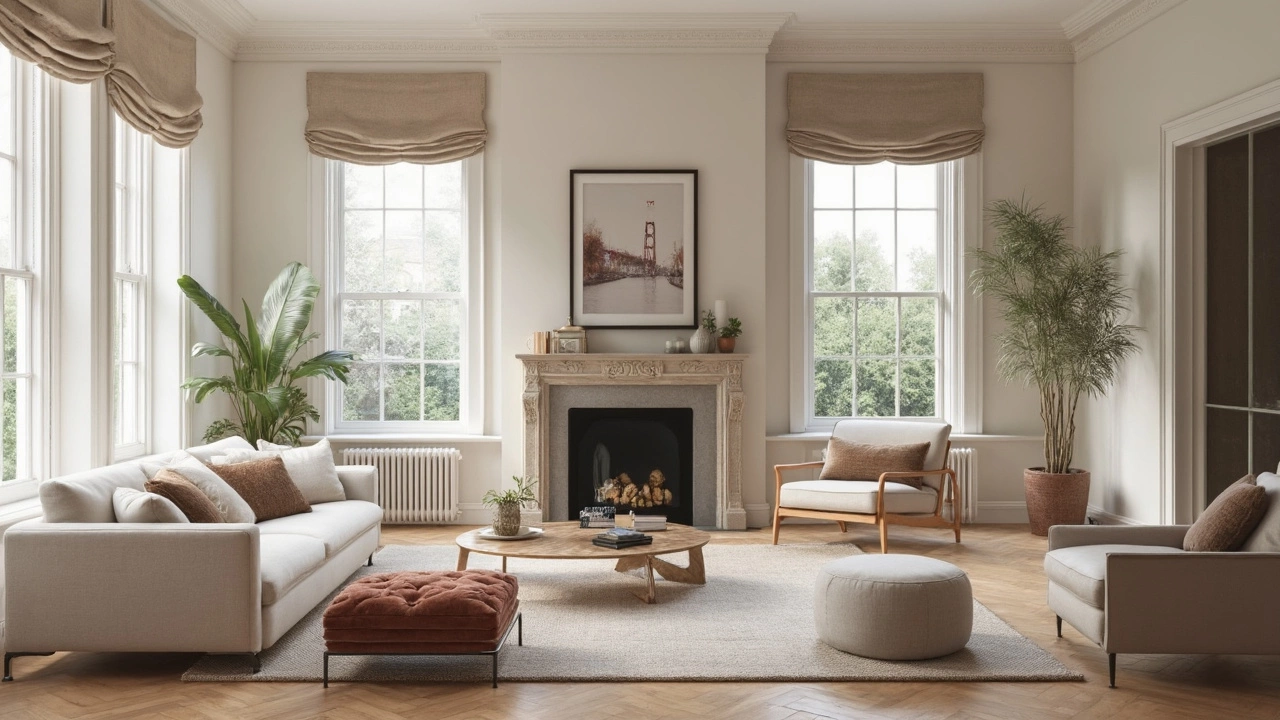No need to knock down walls or toss every family heirloom—giving a traditional home a modern edge isn’t about erasing the past. Think of it like an update, not a total rewrite. One of the fastest ways to shake off the old-school look? Switch up your color palette. Ditch heavy reds, yellows, or browns for crisp whites, soft grays, or charcoal. Even small doses of black can make older details stand out in an intentional way instead of feeling fussy or outdated.
On the surfaces front, glossy finishes and smooth textures win over ornate or rough looks. That bulky oak sideboard from the ‘90s? Sand it down and paint it a sleek neutral, or swap it for something with clean lines. Don’t underestimate how swapping outdated hardware—like antique brass door handles—for matte black or brushed nickel can pull a whole room forward by decades. The real secret? Small changes sprinkled through the house add up fast, and you don’t need a designer’s eye to spot what feels dated versus fresh.
- Swapping Out Colors and Surfaces
- Lighting That Changes Everything
- Mixing Furniture Styles the Right Way
- Declutter, Accessorize, and Add Tech
Swapping Out Colors and Surfaces
Light and neutral tones make rooms feel bigger, cleaner, and fresh. Big-name studies from paint companies—like Sherwin-Williams and Benjamin Moore—report that shades like "Agreeable Gray" or "Simply White" are their top sellers for folks updating older homes. Swapping out beige or cream walls for these trendy hues instantly removes the "stuffy" vibe without much work or mess.
But paint isn’t the only thing that matters. Flooring and surfaces matter too. Old shiny hardwoods with orange or red tones date a space fast. Refinishing them with a matte or satin finish (and a cooler tone, like weathered oak or even painted black) brings a modern look. Laminate or luxury vinyl planks in a pale wood style can do the same for less money and fuss. Also, big square tiles look more "2025" than small busy patterns or faux-marble floors. Simple, right?
- Swap heavy curtains for flat-panel or linen styles in light shades.
- Paint trim and molding to match your wall for a cleaner, seamless look.
- Replace shiny brass hardware with matte black, chrome, or brushed nickel.
- Take out built-in shelves or glass cabinets with lots of decoration and leave open, simple shelves.
- Update old countertops to quartz or concrete-style finishes. Even peel-and-stick options exist these days!
Wondering what makes a bigger impact for your money? Check out this quick comparison:
| Update | Estimated Cost | Visual Impact |
|---|---|---|
| Paint walls | $150-$500 (DIY) | High |
| Refinish floors | $2-4 per sq ft | High |
| Change hardware | $5-$30 per piece | Medium |
| New countertops | $20-$150 per sq ft | High |
Consistency matters, too. If you commit to a modern home look, keep the color and style changes going through connecting rooms. Even swapping out dated light-switch plates or chunky outlets for slim white ones helps keep the vibe current.
Lighting That Changes Everything
If you want to make a modern home out of a traditional space, lighting is like hitting fast-forward. The old rule of one central ceiling fixture per room doesn’t cut it anymore. Layered lighting—combining ceiling lights, wall sconces, and floor lamps—lets you dial the mood up or down, and instantly updates the whole vibe without altering architectural bones.
Try swapping out that old chandelier or dated pendant for something sleeker. Think globe lights, linear LEDs, or flush-mount fixtures with clean shapes. Even replacing yellow bulbs with cooler, daylight-tone LEDs can make moldings and wood shine instead of looking tired. Fact: LED bulbs use up to 75% less energy and last 25 times longer than old incandescents, so you’ll cut your bills too.
Don’t forget the power of accent lighting. Under-cabinet strips in the kitchen, backlit bathroom mirrors, or even tiny LED spotlights pointed at art or built-ins can make old features feel new. Pro tip: Smart bulbs let you control color and brightness from your phone, so you can switch from cozy to bright with a tap.
- Use dimmers on your main lights for flexibility.
- Try minimalist or geometric lamp bases.
- Put lights where you actually hang out—by the sofa, upstairs hallway, or reading corner.
- Add lights behind shelves or under counters for that soft, modern glow.
| Lighting Type | Modern Update | Traditional Alternative |
|---|---|---|
| Overhead | Sleek flush-mount LED | Crystal chandelier |
| Accent | Smart color-changing bulbs | Wall sconces with fabric shades |
| Task | Minimalist lamp with metal base | Decorative table lamp |
Basically, lighting is your shortcut. With a few swaps and a little creativity, you pull your house into the now—no mess, no drama.

Mixing Furniture Styles the Right Way
Dragging that old dining set to the curb isn’t your only option. Mixing furniture styles is actually how most design pros get that fresh, cozy feel in a home—especially when you’re blending traditional bones with a modern home vibe. The sweet spot is “intentional contrast,” not total mismatch. If you keep shapes and proportions balanced, you’ll never end up with an awkward hodgepodge.
Start by picking one thing to modernize in each room. Have a heavy, dark classic sofa? Pair it with a super-minimal coffee table made of glass or light wood. Mixing light and dark, chunky and skinny, helps rooms feel collected—never showroom fake. Mid-century pieces work especially well with older homes, since their clean lines highlight the original features instead of fighting them. West Elm’s Creative Director, Bea Pila, nails it:
"The key to blending furniture styles is not to match, but to balance. A modern chair with a traditional table makes each piece pop."
If you’re stuck, try this quick checklist:
- Keep colors simple—use two main neutrals and layer in one accent color across furniture.
- Repeat similar materials (like light wood or matte metal) in a few small spots to make things flow.
- Don’t overstuff! One traditional piece per room is usually enough to keep some character.
- Edit out overly ornate or fussy decor. Clean lines always help things look more up-to-date.
The payoff? Rooms that actually feel lived-in and unique, instead of frozen in another decade or straight out of a furniture catalog. Modern doesn’t mean cold or cookie-cutter; it’s about letting the old and new play off each other in smart, simple ways.
Declutter, Accessorize, and Add Tech
Let’s be honest—clutter kills any hope of a modern home vibe. Think about it: those knick-knacks, stacks of old magazines, and extra chairs no one sits on just add stale energy and make even pretty rooms feel cramped. Decluttering doesn’t mean turning your house into a museum, but it does mean making space for what matters. Try this: if you haven’t used or enjoyed something in the last year, ask yourself why you still have it. According to a recent survey by the National Association of Professional Organizers, 54% of Americans feel overwhelmed by the clutter in their homes, and 78% have no idea what to do with it. That’s a lot of people living with stuff they don’t even like.
Once you’ve cleared out the distractions, it’s time to actually have fun with the space. Accessories for a modern interior aren’t about stuffing shelves; it’s about picking a few bold, well-chosen pieces. Think a large geometric vase or some quirky artwork instead of rows of tiny collectibles. Plants work wonders—especially in ultra-simple planters. As a bonus, NASA found that some houseplants, like spider plants or snake plants, can help clean indoor air. Just don’t overdo it; the less-is-more approach really makes each piece pop.
Now to the cool part: tech upgrades. Smart home gadgets aren’t just for show—they really tighten up that modern look and make life easier. For example, swapping regular bulbs for smart bulbs lets you adjust lighting with your phone or by voice; Philips Hue and LIFX are two big names here. Even adding a smart thermostat like Nest or Ecobee can save the average U.S. household up to 15% on energy bills yearly. Consider a sleek wireless speaker setup, or wall-mount your TV and hide the cords to keep lines looking sharp. Check out this table for some handy numbers on tech impact:
| Upgrade | Average Cost (USD) | Potential Benefit |
|---|---|---|
| Smart Bulbs (room set) | $80 - $150 | Energy savings, mood lighting |
| Smart Thermostat | $130 - $250 | Save 10–15% on heating/cooling |
| Wireless Speaker | $100 - $400 | Clutter-free, multi-room audio |
| Wall-mounted TV | $100 - $300 (install) | Clean lines, more floor space |
Here’s a simple checklist to get started:
- Sort and donate items you never use
- Keep surfaces clear except for a few modern home style accents
- Choose accessories with bold or clean shapes
- Add one or two easy-care plants
- Install at least one smart device
Refresh doesn’t have to be expensive or overwhelming—tiny changes here have a huge visual payoff, and you barely have to lift a paintbrush.


